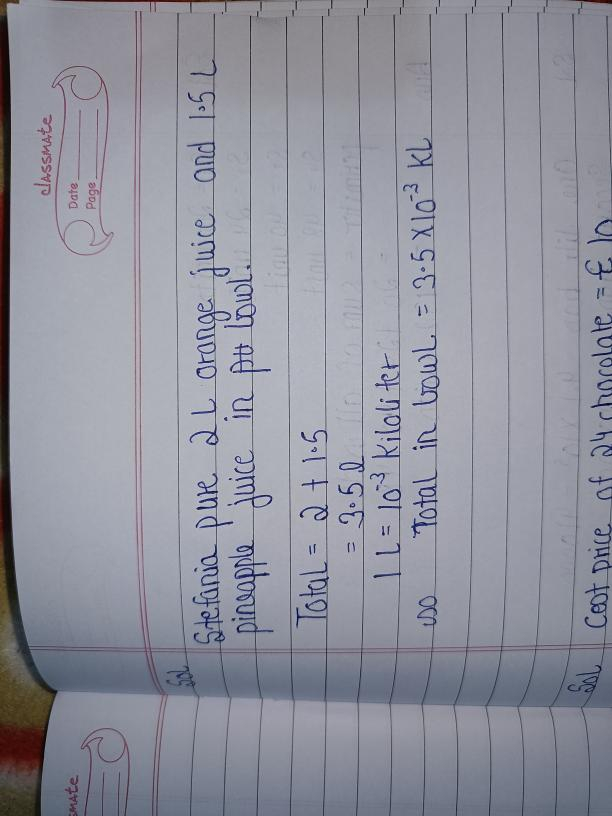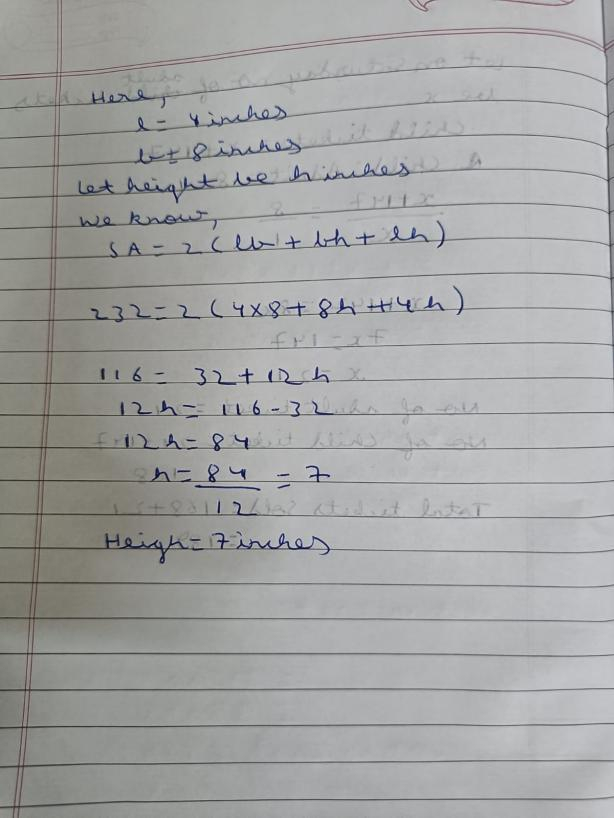 3
3 1. D) decreases, inverse
The average speed for each lap is given by:

where S is the length of the lap (400 m) while t is the time taken to complete the lap. Since the time t increases at each lap, we see from the formula that v, the speed, decreases at each lap. This is an example of inverse relationship: when one of the two quantities increases (the time), the other one decreases (the speed).
2. A) Velocity on the y-axis, time on the x-axis
Acceleration is defined as the change in velocity divided by the time taken:

In a graph, the slope of a line is given by the increment in y divided by the increment in x:

Therefore, if we put velocity on the y-axis and time on the x-axis, we immediately see that the acceleration corresponds to the slope of the curve.
3. D)velocity
In fact, velocity consists of 1) speed and 2) direction. The speed can be calculated as:

where S is the distance covered and t the time taken. So, by knowing these two quantities, Tim can calculate the speed of the trip. Tim also knows the direction of motion, so he can determine the velocity of the trip.
4. B)equal, different
The difference between speed and velocity is simple: speed is a scalar, and it is just the magnitude of the velocity, so "how fast" is the object moving, while velocity takes also into account the direction of motion, so it is a vector.
Therefore: the two cars have same speed (25 m/s), but they have different velocities, since they are moving into different directions (car A is moving from NY to Miami, while car B is moving from NY to Chicago).
28. B) 11 m
The distance travelled by the bag in free fall is given by:

where  is the acceleration of gravity and t=1.5 s is the time. Replacing these numbers into the formula, we find
is the acceleration of gravity and t=1.5 s is the time. Replacing these numbers into the formula, we find

29. B)10 m/s south
The boat is moving 20 m/s south, relative to the ground. The passenger is moving 10 m/s north, relative to the boat. Considering south as positive direction, the passenger's velocity relative to the ground is

and the positive sign means it is due south.
30. B)direction
In fact, velocity is a vector, so it consists of a magnitude (the speed) and a direction. The speed can be determined by the distance and the time, in fact speed is defined as

where d=distance and t=time; however, in order to determine velocity, we also need to know the direction of motion.
33. B)a velocity.
In fact, velocity is a vector, and it consists of a magnitude (the speed) and a direction. In this case, 10 m/s is the speed, while north is the direction.
34. C)Does the measurement include direction?
As stated in the previous question, a vector includes both magnitude and direction, while a scalar includes only a magnitude. Therefore, by asking if the measurement includes a direction, we are able to determine if the quantity is a vector or not.
 3
3 1. D) decreases, inverse
The average speed for each lap is given by:

where S is the length of the lap (400 m) while t is the time taken to complete the lap. Since the time t increases at each lap, we see from the formula that v, the speed, decreases at each lap. This is an example of inverse relationship: when one of the two quantities increases (the time), the other one decreases (the speed).
2. A) Velocity on the y-axis, time on the x-axis
Acceleration is defined as the change in velocity divided by the time taken:

In a graph, the slope of a line is given by the increment in y divided by the increment in x:

Therefore, if we put velocity on the y-axis and time on the x-axis, we immediately see that the acceleration corresponds to the slope of the curve.
3. D)velocity
In fact, velocity consists of 1) speed and 2) direction. The speed can be calculated as:

where S is the distance covered and t the time taken. So, by knowing these two quantities, Tim can calculate the speed of the trip. Tim also knows the direction of motion, so he can determine the velocity of the trip.
4. B)equal, different
The difference between speed and velocity is simple: speed is a scalar, and it is just the magnitude of the velocity, so "how fast" is the object moving, while velocity takes also into account the direction of motion, so it is a vector.
Therefore: the two cars have same speed (25 m/s), but they have different velocities, since they are moving into different directions (car A is moving from NY to Miami, while car B is moving from NY to Chicago).
28. B) 11 m
The distance travelled by the bag in free fall is given by:

where  is the acceleration of gravity and t=1.5 s is the time. Replacing these numbers into the formula, we find
is the acceleration of gravity and t=1.5 s is the time. Replacing these numbers into the formula, we find

29. B)10 m/s south
The boat is moving 20 m/s south, relative to the ground. The passenger is moving 10 m/s north, relative to the boat. Considering south as positive direction, the passenger's velocity relative to the ground is

and the positive sign means it is due south.
30. B)direction
In fact, velocity is a vector, so it consists of a magnitude (the speed) and a direction. The speed can be determined by the distance and the time, in fact speed is defined as

where d=distance and t=time; however, in order to determine velocity, we also need to know the direction of motion.
33. B)a velocity.
In fact, velocity is a vector, and it consists of a magnitude (the speed) and a direction. In this case, 10 m/s is the speed, while north is the direction.
34. C)Does the measurement include direction?
As stated in the previous question, a vector includes both magnitude and direction, while a scalar includes only a magnitude. Therefore, by asking if the measurement includes a direction, we are able to determine if the quantity is a vector or not.
 1
1 2. In the first year, Geoff’s garden produced 6 bulbs. In the second year, it produced 12=6·2 bulbs, and in the third year, it produced 24=12·2 bulbs. If this pattern continues, then he can expect 24·2=48 bulbs in the fourth year, 48·2=96 bulbs in the fifth year, 96·2=192 bulbs in the 6th year, 192·2=384 bulbs in the 7th year and 384·2=768 bulbs in the 8th year.
Answer 2: correct choice is C.
3. Given n(n – 1) – 5 you can find:
for n=1, 1·(1-1)-5=-5;for n=2, 2·(2-1)-5=-3;for n=3, 3·(3-1)-5=1;for n=4, 4·(4-1)-5=7.Answer 3: correct choice is D.
6. Given the function rule f(x) = x² – 5x + 1,
f(-3)=(-3)²-5·(-3)+1=9+15+1=25.
Answer 6: correct choice is C.
7. Suppose you earn $10 each hour you babysit and your total earnings E depending on the number of hours h you babysit is
E(h)=10·h.
Answer 7: correct choice is A.
8. If Melanie charges $4.50 per hour, then she she charges $4.50·x for x hours. Plus $5.00 for supplies, then the function rule is
y=4.50x+5.00.
Answer 8: correct choice is B.
14. The sale price of apples at a local grocery store is $1.35 for the first pound and $1.10 for each additional pound. If x is the number of sold pounds then 1 was sold for $1.35 and rest x-1 were sold for $1.10. This means that
y=1.10(x-1)+1.35
Answer 14: correct choice is A.
 1
1 2. In the first year, Geoff’s garden produced 6 bulbs. In the second year, it produced 12=6·2 bulbs, and in the third year, it produced 24=12·2 bulbs. If this pattern continues, then he can expect 24·2=48 bulbs in the fourth year, 48·2=96 bulbs in the fifth year, 96·2=192 bulbs in the 6th year, 192·2=384 bulbs in the 7th year and 384·2=768 bulbs in the 8th year.
Answer 2: correct choice is C.
3. Given n(n – 1) – 5 you can find:
for n=1, 1·(1-1)-5=-5;for n=2, 2·(2-1)-5=-3;for n=3, 3·(3-1)-5=1;for n=4, 4·(4-1)-5=7.Answer 3: correct choice is D.
6. Given the function rule f(x) = x² – 5x + 1,
f(-3)=(-3)²-5·(-3)+1=9+15+1=25.
Answer 6: correct choice is C.
7. Suppose you earn $10 each hour you babysit and your total earnings E depending on the number of hours h you babysit is
E(h)=10·h.
Answer 7: correct choice is A.
8. If Melanie charges $4.50 per hour, then she she charges $4.50·x for x hours. Plus $5.00 for supplies, then the function rule is
y=4.50x+5.00.
Answer 8: correct choice is B.
14. The sale price of apples at a local grocery store is $1.35 for the first pound and $1.10 for each additional pound. If x is the number of sold pounds then 1 was sold for $1.35 and rest x-1 were sold for $1.10. This means that
y=1.10(x-1)+1.35
Answer 14: correct choice is A.
The total nom of code that can be used is equal to 5+3 = 8
F=ma
where F=force
m=mass
a=acceleration
Here,
F=4300
a=3.3m/s2
m=F/a
=4300/3.3
=1303.03kg

The answer is in the image
The solution is given in the image below

Speed=Distance/time
Here,
distance=15m
time=1sec
speed=15/1=15m/sec
Distance=Speed*time
time=15min=15*60sec=900sec
Distance travelled in 15 min=15*900=13,500m
=13500/1000 km=13.5Km
30% of 420 are first year students
first year students = (30/100 )*420
=126 students
Student who are not in first year = 420-126
=294 students

It will provide an instant answer!
